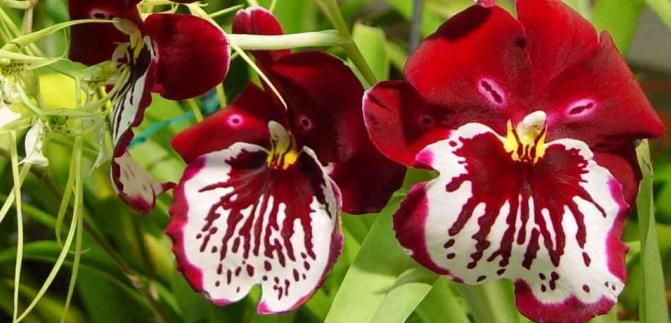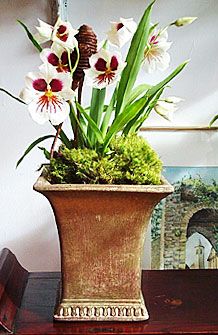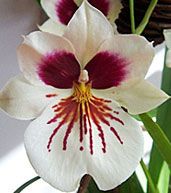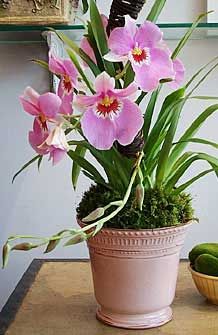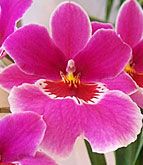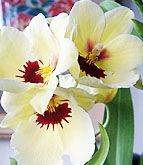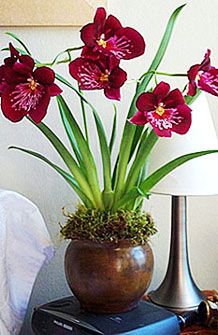Miltonia (orchid)
Common name: Pansy Orchid
Family: Orchidaceae
Expusure: diffused light
Water: they require a drying period
Temperature: 70-85 F by day and 55-65 F by night
|
|
|
Description
The popularity of the Miltonia orchid is increasing rapidly, thanks in part to the development of rigorous hybrid methods that can produce plants in greater quantities. Because of the familiar shape and markings of these spectacular flowers, Miltonia are often called Pansy Orchids. Their richly colored flowers blossom profusely. Although they may last for up to a month, their bloom time is as short as that of a cut flower. Miltonia can easily be cultured at home or in a greenhouse. They normally bloom in the spring or fall.
Miltonia's are named in honour of Earl Fitzwilliam and Viscount Milton. Growers have divided the Pansy orchids into two groups, Miltonia and Miltoniopsis. Miltonias are warm-growing orchids which come from Brazil and Miltoniopsis, come from Columbia, are moderate temperature growers from the foothills. These charming irresistible plants bloom profusely. The richly colored, fragrant flowers are borne on slender arching stems and can reach to sizes of 2-3 inches in width. Flowers vary in colors: red, white, pink with different colored markings and yellow. Although they may last for up to a month, their bloom time is as short as that of a cut flower.
Miltonias may be a little difficult to grow, but if necessary temperature and lighting requirements are provided, they can be grown in the home or greenhouse. Miltonia's like an open compost that does not hold excessive amounts of water. It prefers tree-fern fibre mixed with perlite and bark composts.
|
|
|
Care and cultivation
Temperature and humidity
The ideal day temperature is 70-85 degrees F., while the ideal night temperature is 55-65 degrees F. Growth in summer is rapid at temperatures up to 26 C. Occasional temperature extremes are tolerated if exposure is not prolonged. As long as you keep the temperature reasonable, you should have a healthy plant. A humid atmosphere, propelled by a fan is beneficial. Miltonia enjoy moist air, requiring a minimum of 55 to 65% humidity. An increase in humidity is needed to reduce the stress on the plants when the temperature and lighting intensity increases.
Light
Bright diffused light is necessary to bring Miltonia into bloom; this can include a little sun (not direct sunlight) for up to two hours a day. In hot weather shade sufficiently to ensure that the leaves are cool to the touch. If you are growing in the home give a bright situation but not direct sunlight, behind a net curtain, from April to September. These also make good conservatory plants as long as summer shade and good air movement can be provided.
Watering and fertilising
The compost should never be allowed to dry out completely, with more abundant waterind in summer when you should water twice weekly and fertilise fortnightly with a recommended orchid fertiliser. Ensure that the compost is throughly flushed through when not applyind fertiliser to remove any build up of salts, which will damage the roots. Depending upon the temperature, Miltonias should be watered twice a week. Water carefully and do not allow water to stand in the leaves or soft rot may occur.
Unlike some orchids that require a drying out period, Miltonia grow throughout the entire year and must be kept evenly moist. Drench the plant in the early morning and let them dry out before nightfall. Once a week watering during the winter and twice a week during summer is normally sufficient.
High-nitrogen fertilizers (25-9-9) can be used year-round at one teaspoon per gallon of water. Feed once a month with half-strength nitrogenous fertilizer. Fertilize approximately twice per month when new growth is developing.
|
|
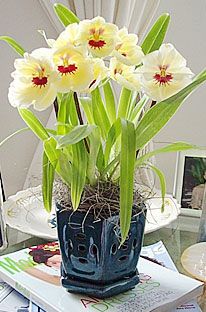 |
|
|
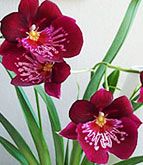 |
Compost and potting
A medium bark mix will do well with added polystyrene spheres or perlite to keep it open. New compost will keep the plant growing well for no more than twelve months or so, the best time to repot is when the new shoots are just beginning to appear at the older shoot's bases. If the plant has over three pseudobulbs, the rhizome can be cut to give two equal sized plants which can be potted separately.
Repot your Miltonia at least once every 2 years or when the potting medium begins to decay.
Pests and diseases
The leaves on the miltonia plant should be light green. If the leaves are dark green, increase lighting. If the leaves turn yellowish green or reddish, increase shading.
Common pests associated with Miltonias are scale, spider mites and aphids.
Articole asemănătoare
-
Miltonia, frumusetea Americii Latine intr-un ghiveci de flori
Marele grup al orhideelor include o varietate de apartament declarata convingator de specialisti “floarea lunii Mai”. Miltonia este confundata uneori cu trei frati patati din cauza aspectului, chiar daca botanic vorbind cele doua nu sunt in relatie de rudenie.
-
Cum avem toamna o gradina multicolora?
Rand pe rand frunzele au inceput sa se usuce si sa cada. Pentru oamenii gospodari este semn ca multe dintre uneltele de care nu s-au putut lipsit in timpul verii vor sta de acum in asteptarea viitorului sezon estival.
-
Orhidee Oncidium, delicatete si abundenta florala
Se acomodeaza usor in spatii cu temperaturi variate, dar cel mai bine se dezvolta la 22-24 de grade Celsius. Vara tolereaza cateva grade in plus, cu conditia sa i se asigure o umiditate atmosferica constanta, prin pulverizarea periodica a tuturor partilor aeriene. Iarna se multumeste cu o medie de 18 grade Celsius, dar supusa la acest nivel al temperaturilor, pe o perioada indelungata, va stagna in crestere si nu va inflori.
-
Decor interior la inceput de toamna
Alegeti plante cu flori sau fructe frumos colorate ori exotice orhidee, considerate uneori, in mod exagerat, greu de ingrijit.
-
Miltonia (orhidee)
Denumire populara: orhidee panseluta, orhidee Miltonia. Familie: Orchidaceae. Florile au culori vii si apar din abundenta. In mod normal, Miltonia infloreste primavara sau toamna. Orhideea Miltonia poate fi o planta dificil de cultivat...
